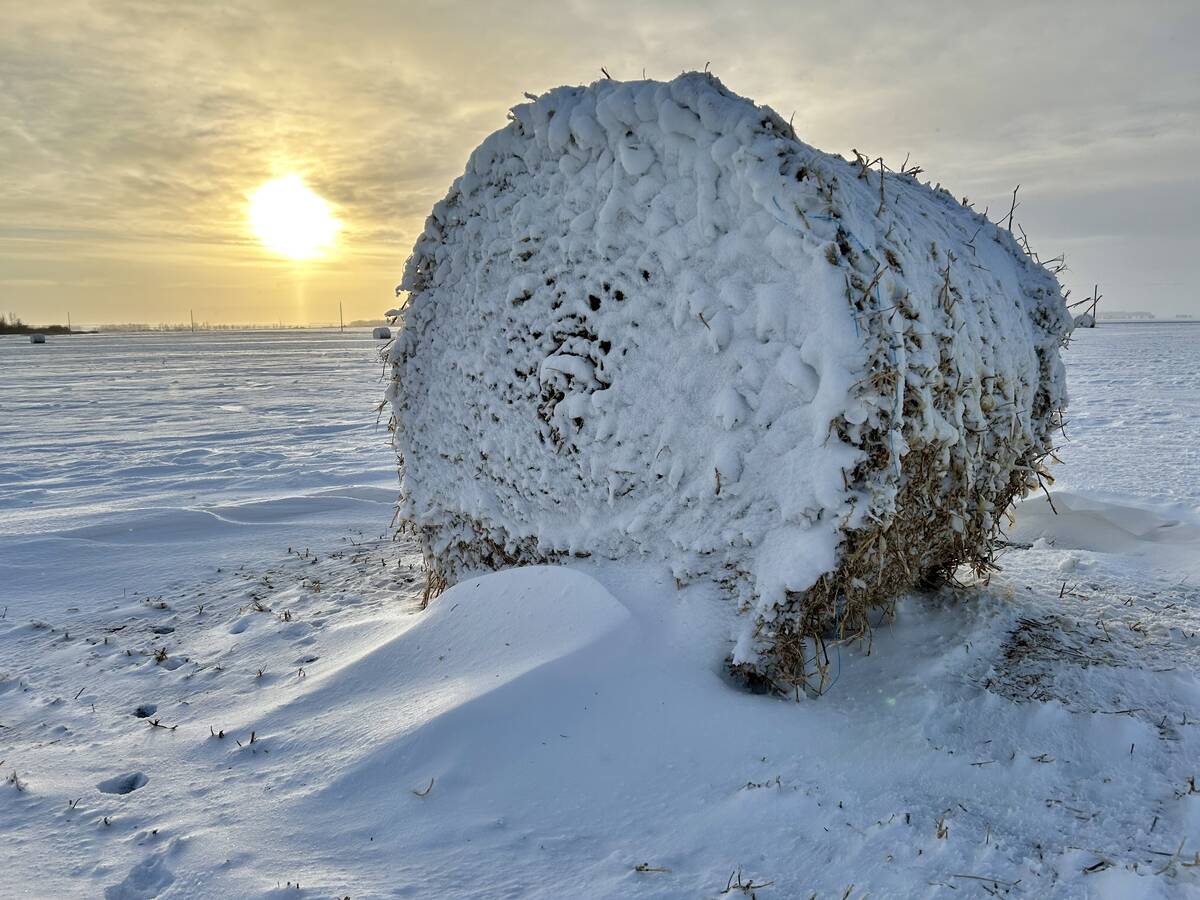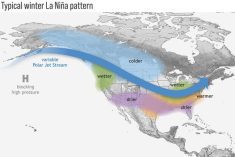Glacier FarmMedia – Factors resulting in extreme rainfall events range from lots of atmospheric moisture to different triggers such as orographic or frontal lift, instability, speed of storm systems, and the training of thunderstorms.
We will look at the different weather patterns that tend to be associated with rainfall and tie in changing weather patterns and how they might contribute to extreme rainfall. But first, let’s look at some of the rainfall records.
There are several types of rainfall or precipitation records. Yearly precipitation includes rain and snowfall. And you can look at monthly rainfall totals, daily totals or storm totals.
Read Also

Prairie winter snowfall forecast 2025-2026
How much snow should farmers in Alberta and elsewhere on the Canadian Prairies expect for the rest of December 2025 and into January-February 2026?
When analyzing data, yearly, monthly and daily totals are relatively easy. Storm totals are more difficult because precipitation extends over one or more days, and it is difficult to look at the information saved as daily data and determine what was one large single event and what was two or more events over two or more days.
Over the winter I hope to gain access to a new dataset that will let me dig deeper into different weather events. I have included a map that shows the largest one-day rainfall totals across Alberta.
Extreme or heavy rainfall can happen from any one of several conditions, but often it is a combination of conditions that leads to record-breaking rainfall. You could have ‘training’ thunderstorms that occur in sequence, but if there is not much available moisture, you will not get extreme rainfall.
Same thing goes for a strong area of low pressure. It might have lots of moisture and plenty of instability, but if it is moving fast, rainfall totals will not be extreme.
If you looked at all the one-day rainfall records across the Prairies, you would find that nearly all occur in either late May, June, July or August, which happens to be thunderstorm season. Thunderstorms that bring extreme rainfall usually have several conditions that come together. There will be plenty of moisture, atmospheric instability, some form of front providing lift, and slow speeds or training of storms.
Plenty of moisture and slow movement of systems are the two main conditions. With changes that our atmosphere is undergoing due to a warming planet, these two conditions look to become more prevalent.
A warmer atmosphere and ocean are leading to an increase in available atmospheric moisture. This doesn’t mean we won’t have dry conditions. Sure, a warmer atmosphere can hold more moisture, but if the atmosphere is dry, it will be able to pull more moisture out of a region through evapo-transpiration.
Overall, it looks like the atmosphere can and will hold more moisture and that moisture will be available to produce rainfall. There is also emerging evidence that a warming planet is leading to a slowing of weather systems and development of more blocking patterns.
Blocking patterns are when certain configurations of highs and lows develop that don’t move much. They block the movement of weather systems. Blocking patterns can bring long periods of warm, dry weather, but they can also bring long periods of cool, wet weather. It all depends on where you are in relationship to the block.
Why the slow down? As the planet warms, the poles warm significantly faster than the equatorial regions. This lessens or weakens the temperature gradient between these two regions. This temperature gradient is the driving force behind most atmospheric circulations such as the jet stream.
As the atmospheric circulation weakens, systems will move slower and the pattern will be more meandering. Think of a river. If it is flowing down a steep hill, it tends to stay relatively straight. When it is flowing slowly across a flat region, like the Prairies, it meanders.
The same thing happens with the flow of the atmosphere, and when it gets curvy, it can get stuck in a curve until that curve breaks off, just like when a river meanders and eventually forms an oxbow.
Are we going to see a continuation of the slowdown and more meandering and blocking patterns in the future? I think so. Chances are, we will see more shifting between dry and wet patterns. Sometimes it will be in short time frames of dry one month and wet the next. Other times, over longer periods, one year will see very wet conditions and the next year very dry.
In the next issue, we will look back at summer 2023 and look ahead to see what the different long-range forecasts call for in the last three months of the year.
The odds of the current El Nino event lasting through the winter are above 95 per cent. Will we see the typical effects or will some other weather phenomena, such as the polar vortex, dominate?
– This article was originally published at the Manitoba Co-operator.
















